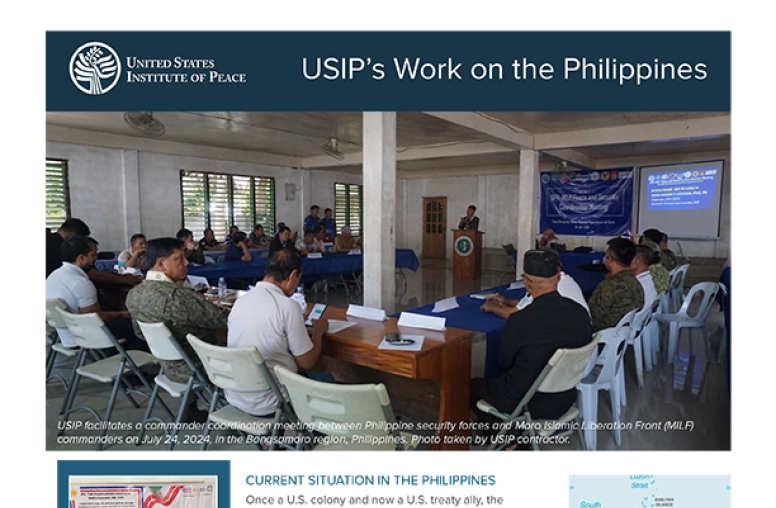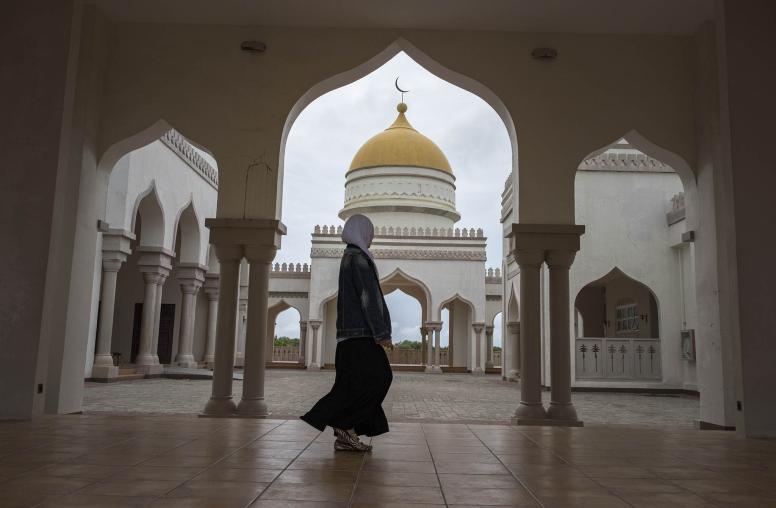Examining the Military’s Soft Power Challenge in the Southern Philippines
Military’s overemphasis on kinetic successes in Mindanao risks antagonizing communities and hardening anti-military perceptions.
Editor’s Note: The Armed Forces of the Philippines (AFP) have a vital role to play in protecting Bangsamoro peace efforts from a range of armed groups operating across Mindanao. Decades of fighting local insurgencies and terrorist groups have honed the AFP’s kinetic capabilities to fight non-state violent threats. However, in part five of this USIP editorial series examining the conflict-marred Southern Philippines, regional security analyst Joseph Franco explores how the AFP’s broader non-kinetic soft power capabilities remain underdeveloped.
This is a moment of both real and potential transition for the AFP, as the prospect of sustainable peace in the Bangsamoro Autonomous Region in Muslim Mindanao (BARMM) and at least wearying of non-state threats could enable a transition in force posture from a focus on internal security operations to broader regional defense.

Recent internal security operations (ISOs) by the Armed Forces of the Philippines (AFP) in Mindanao highlight important advancements in kinetic military capabilities to confront violent groups in the restive south. But while it may seem that the AFP is on track to meet its target to defeat — or at least seriously degrade — two of the most significant threats to the nation’s internal security, advancements in the AFP’s kinetic operations need to be balanced by complementary improvements in non-kinetic soft power capabilities to confront a variety of threats that will challenge stability within the Philippines.
In October, the AFP in quick succession killed Salahuddin Hassan, the leader of Islamic State-linked Dawlah Islamiyah (DI) in Maguindanao province; and Jorge Madlos, head of the New People’s Army (NPA) National Operations Command. The Communist Party of the Philippines-New People’s Army (CPP-NPA) seeks to overthrow the Philippine government in favor of a new state led by the working class and to expel U.S. influence from the Philippines.
Given its recent investments in strike capabilities, the AFP’s military successes are hardly surprising. The Philippine Air Force (PAF) and the Philippine Navy (PN) have acquired multirole frigates and attack helicopters — harbingers of a joint force transitioning into a more conventional military force. A recent deal with India to procure BrahMos anti-ship missiles further underscored how the AFP is moving beyond just articulating a desired shift to external defense to actually procuring and developing the necessary capabilities.
A Broad Spectrum of Threats
The communist insurgency and Islamist militancy represent the primary internal threats to the Philippines, and both are active in Mindanao. Consequently, each new chief of staff of the AFP (CSAFP) typically begins their appointment with a promise of ending either the communist insurgency, Islamist militancy, or both. However, recent claims that the communist insurgency can be defeated by 2022 could very well prove premature. In 2021, the AFP estimated that there were around 3,000 NPA fighters operating nationwide, down from nearly 30,000 fighters at end of the Marcos regime in the mid-1980s. More than half of these fighters operate in communist strongholds in eastern Mindanao. As for groups linked to the Islamic State (IS), various factions in central and western Mindanao number between 300 and 500. This estimate has remained fairly constant since 2014, the year Philippine-based groups pledged allegiance to the late IS caliph Abu Bakr al-Baghdadi.
However, the challenges facing the AFP are more diverse than the communist insurgency and IS-aligned groups. The Southern Philippines region is host to an array of armed factions, not just violent extremist groups. Of the various armed militias that proliferate in the region, some directly support state actors, others operate to dispense violence for political clans or players in illicit economies. Translated to the village or barangay level, the AFP may be first among equals, but is hardly alone in exercising legitimate coercion and force in communities.
AFP in Support of Bangsamoro Peace
Factionalism and the resultant fracturing of the rule of law is a recurring challenge for the BARMM. The BARMM was inaugurated in 2019, the result of a long-running peace process between Manila and the secessionist Moro Islamic Liberation Front (MILF). What was supposed to be a three-year transition period led by appointed members of the Bangsamoro Transition Authority (BTA) was extended until 2025 by Philippine President Rodrigo Roa Duterte. The impact of the COVID-19 pandemic on the BARMM was the primary justification cited for the extension.
The AFP’s main role in supporting the BTA’s exercise of governance is to build the capacity of the latter’s nascent security sector. A key policy initiative is for a normalization process hinged on demobilizing 40,000 former MILF combatants. For the AFP, the first step to normalization is the training and organization of 200 Joint Peace and Security Teams (JPSTs) that would spearhead law enforcement in Philippine government-recognized MILF camps. Two years on, however, the normalization process has failed to normalize Mindanao. In some cases, JPSTs have induced violence. It remains uncertain how well the AFP has learned its lessons from working with its former adversaries in the MILF.
The extension of the BARMM transition period may have shelved local electoral contests in the region — however, elections for national-level posts, including the next president of the Philippines, are still scheduled for this year. In Mindanao, local candidates across “27 provinces, 33 cities, and 422 municipalities” are now filing their certificates of candidacy. In short, the BARMM will find itself adjacent to jurisdictions that often see election-related spikes in violence. While the AFP has been able to tamp down outbreaks of conflict between private militias wielded by politicians, such conflicts can distract from sustaining gains made against the NPA and the IS-linked groups.
The Other Side of Kinetic Ops
Keeping the peace using direct kinetic means or indirectly via capacity building is arguably easy to quantify. What is more difficult is determining how effective the AFP’s soft power is in comparison to its adversaries’. During the battle for Marawi in 2017, the AFP managed to portray itself as a defender of the city, at least in the eyes of the majority Tagalog and English-language social media user base. However, it would seem that since the pandemic, its messaging, particularly online, has reverted to old methods that prioritized combative speech rather than coalition building.
Despite claims that it has embarked on more sensitive campaigns to prevent violent extremism, AFP messaging remains inflexible. During commemorations of the battle for Marawi, AFP social media campaigns repeatedly portray themselves as liberators of the city. With every unveiling of a commemorative plaque or a battle marker, AFP social media sites are met with an organic response from Muslim Filipinos online, criticizing the military for the destruction of the city — or, more pointedly, prioritizing public relations stunts over meaningful reconstruction. The outspokenness of some military officers on social media has led to fear of increased “red-tagging” — accusing individuals of NPA membership. The practice runs contrary to the AFP’s social media policy that was promulgated in 2016. With the May 2022 polls approaching, tensions fueled on or by social media are likely to intensify.
Conclusions and Recommendations
The AFP has long subscribed to and promoted the idea of a “whole-of-government” and even a “whole-of-nation” approach to addressing internal threats. However, information campaigns highlighting improvements in kinetic military operations have not been complemented by more nuanced depictions of AFP soft power. With this backdrop, AFP operations in Mindanao may be less effective than portrayed. Overemphasis on highlighting kinetic successes may inadvertently antagonize communities and harden anti-military perceptions.
There are some short-term policy fixes that can be implemented to address this disparity between kinetic and non-kinetic domains. First, the AFP’s nonpartisan policy should be emphasized repeatedly, with meaningful sanctions imposed on all AFP personnel, including top-ranking officials, who violate this policy. There should also be sustained advocacy activities to inform AFP personnel and their dependents of the importance of nonpartisanship online. Second, JPSTs’ capacity building should be prioritized and not simply viewed as secondary to ISOs and warfighting in general. This could include increasing, where possible, staffing for training cadre and closely working with other non-security stakeholders in the BTA.
Some members of the AFP appear set on transitioning the force into a more traditional, outward-looking external defense force, weaning it away from its ISO/constabulary mission. The AFP in November concluded the fifth iteration of its joint exercises (AJEX DAGIT-PA), which focused on complex amphibious operations and even island-retaking drills. It was a strong signal of the growing role of the PN and PAF in the AFP’s joint planning compared to the previously heavy focus on ISO which meant the dominance of army requirements and doctrine in joint force planning. For the AFP, addressing threats posed by armed groups in Mindanao and orienting itself as a nonpartisan force nationwide cannot be overlooked if such a force transition is to be achieved.
Joseph Franco is a regional security analyst that previously worked for the AFP joint staff.



